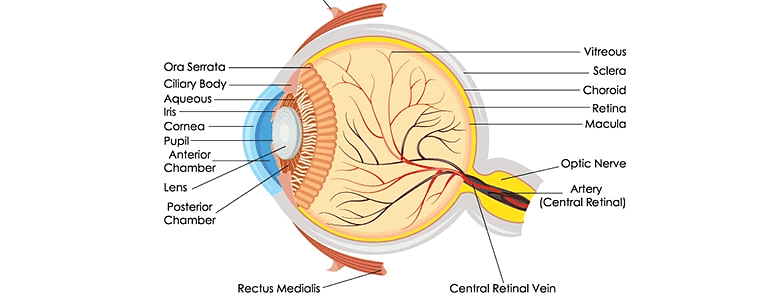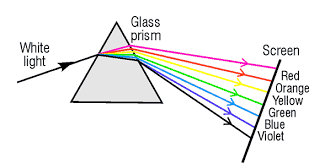Class 10 Exam > Class 10 Notes > Science Class 10 > Overview: The Human Eye & the Colorful World
Overview: The Human Eye & the Colorful World | Science Class 10 PDF Download
| Table of contents |

|
| The Human Eye |

|
| Defects of Vision and Their Correction |

|
| Refraction of Light Through a Prism |

|
| Dispersion of White Light by a Glass Prism |

|
| Atmospheric Refraction |

|
| Scattering of Light |

|
The Human Eye
- The human eye is a crucial sense organ that helps us see the vibrant world around us.
- Its structure is similar to a camera, with a lens system that projects images onto the light-sensitive retina.
- Most of the bending of light rays happens at the front surface of the cornea.
- Light enters through the cornea, while the crystalline lens fine-tunes the focus for objects at various distances.
- The iris, a dark muscle behind the cornea, regulates the size of the pupil, controlling the light that enters.
- The lens creates an upside-down image on the retina, which is a thin membrane filled with many light-sensitive cells.
- These cells send electrical signals to the brain via the optic nerves, allowing us to see and understand our surroundings.

Power of Accommodation
- The eye lens, composed of a fibrous, jelly-like material, adjusts its curvature through ciliary muscles.
- Accommodation allows the eye to focus on distant objects (relaxed muscles, thin lens) or nearby objects (contracted muscles, thicker lens).
- The minimum distance for clear vision, called the least distance of distinct vision, is approximately 25 cm.
Defects of Vision and Their Correction
- Common vision problems include myopia (nearsightedness), hypermetropia (farsightedness), and presbyopia (age-related loss of accommodation).
- Myopia is corrected with concave lenses, hypermetropia with convex lenses, and presbyopia with bifocal lenses.
- Cataract occurs when the lens becomes cloudy, leading to vision loss, and can be treated with surgery.
Refraction of Light Through a Prism
- A triangular glass prism refracts light, creating a spectrum of colors.
- Activity: Observation of refraction through a prism, demonstrating the angle of deviation.

Dispersion of White Light by a Glass Prism
- Newton's experiment with a prism demonstrated that white light consists of seven colours: Violet, Indigo, Blue, Green, Yellow, Orange, and Red. You can remember the order using the acronym VIBGYOR.
- Dispersion happens when light travels through a prism, separating colours due to varying angles of refraction.
- A rainbow is a natural spectrum seen in the sky after rain, caused by the dispersion of sunlight through tiny water droplets in the atmosphere. It always appears in the opposite direction of the Sun.
Atmospheric Refraction
- Atmospheric refraction creates effects like the twinkling of stars, earlier sunrises, and later sunsets.
- You may notice objects appearing to flicker when viewed through a hot air stream above a fire or radiator. The air above the fire is hotter and less dense than the cooler air above it, affecting its refractive index.
- The Sun is visible before sunrise and after sunset due to this bending of light around the Earth's curvature.
Scattering of Light
Tyndall Effect
- Colloidal particles in the atmosphere cause the scattering of light, making paths visible.
- Tyndall effect is observed in smoke-filled rooms or misty forests, demonstrating light scattering by fine particles.

Why is the Colour of the Clear Sky Blue?
- Molecules and particles in the atmosphere scatter shorter wavelengths (blue) more effectively than longer wavelengths (red), making the sky appear blue.
- The absence of atmosphere would result in a dark sky, as there would be no scattering of light.
Note: Activities and specific questions from the original text have been excluded, focusing on the overview and key points.
The document Overview: The Human Eye & the Colorful World | Science Class 10 is a part of the Class 10 Course Science Class 10.
All you need of Class 10 at this link: Class 10
|
80 videos|569 docs|80 tests
|
FAQs on Overview: The Human Eye & the Colorful World - Science Class 10
| 1. What are the common defects of vision and how can they be corrected? |  |
Ans. The common defects of vision include myopia (nearsightedness), hyperopia (farsightedness), and astigmatism. Myopia can be corrected using concave lenses, which help diverge light rays before they enter the eye. Hyperopia is corrected with convex lenses, which converge light rays to focus them correctly on the retina. Astigmatism is corrected with cylindrical lenses that compensate for the uneven curvature of the cornea.
| 2. How does a prism refract light and what is the significance of this property? |  |
Ans. A prism refracts light by bending it as it passes through the material, changing its direction due to the difference in speed of light in air and glass. The angle at which light enters and exits the prism determines the degree of refraction. This property is significant in optics, allowing for the analysis and manipulation of light, such as in the creation of optical instruments and in understanding the behavior of light.
| 3. What is the phenomenon of dispersion of white light by a glass prism? |  |
Ans. Dispersion of white light occurs when it passes through a glass prism, separating it into its constituent colors (red, orange, yellow, green, blue, indigo, and violet). This happens because different colors of light travel at different speeds in glass, causing them to refract at various angles. The result is a spectrum of colors, commonly referred to as a rainbow effect.
| 4. What role does atmospheric refraction play in our daily lives? |  |
Ans. Atmospheric refraction is the bending of light rays as they pass through different layers of the Earth's atmosphere with varying densities. This phenomenon affects how we perceive objects, making them appear higher than they actually are, and causes the distortion of distant objects. It also plays a role in the formation of optical phenomena like mirages and the apparent position of stars.
| 5. What is the process of scattering of light, and how does it affect the color of the sky? |  |
Ans. Scattering of light is the process by which light rays are deflected in various directions when they encounter small particles or molecules in the atmosphere. This process is responsible for the blue color of the sky; shorter wavelengths of light (blue) are scattered more than longer wavelengths (red). During sunrise and sunset, the light travels through a thicker atmosphere, scattering the shorter wavelengths and allowing the longer wavelengths to dominate, resulting in reddish hues.
Related Searches















